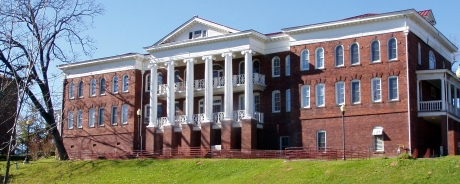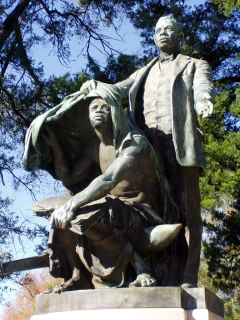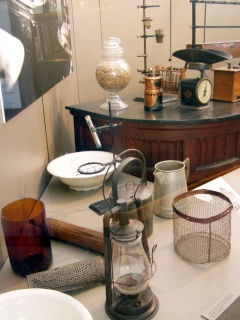NPS Website; University Website
 WHAT IS IT?
WHAT IS IT?The grounds of the University that Booker T. Washington literally built from the ground up. The Site celebrates the life and accomplishments of both Washington and George W Carver, who spent over 40 years of his life teaching at Tuskegee Institute. The school itself is the National Historic Site.
BEAUTY (7/10)
Tuskegee Institute’s buildings, quads and atmosphere feel collegiate. African-American architect R.R. Taylor who was, in 1892, the first black M.I.T. graduate designed most of the buildings. The red-bricked structures are built in a mish-mash of classical American architectural styles. Not only were these the first major works done by an African-American architect but the bricks were laid and the masonry done by the first Tuskegee students.
HISTORICAL INTEREST (7/10)
Tuskegee Institute NHS’s place in the Park System is to represent post-reconstruction African-American life. Booker T. Washington and George W Carver were two of the greatest Americans of their era. While they both enjoy their own National Park Sites (located at their respective birthplaces), Tuskegee Institute is where they accomplished most of their successes. Their stories are unbelievable. Both were born slaves in 1864 and by 1915 had become prominent Americans in their widely dissimilar fields.
Washington and Carver were not without their African American detractors. The Park’s film does a good job of introducing the W.E.B. DuBois – Booker T. Washington debates on the progress of the black race. Washington has faced much criticism, both from DuBois and from present-day historians for his many accommodationist attitudes towards white oppression.
This Site ably acknowledges the criticism. It shows Washington to have been a complex man, one who believed that industrial knowledge begat economic and monetary advancement. He did not push to regain the lost African-American suffrage or for basic human rights issues. The Site explains his path by placing him within the social milieu of Deep South Alabama, describing the hostile political and racial climate around Tuskegee in contrast to the Massachusetts upbringing of DuBois.
Washington ran Tuskegee Institute from 1881 until his death in 1915. Under Washington’s tutelage, Tuskegee emphasized vocational industrial education and became notable for its extraordinary achievements in agriculture (under Carver), architecture and practical chemistry. The Institute elicited large donations and patronage from northern white luminaries like Andrew Carnegie, President William McKinley and John D. Rockefeller.
Even though they do not fit into the timeline of Washington’s reign at Tuskegee Institute, we wondered why the NHS’s Museum made no mention of the infamous Tuskegee syphilis experiments. The United States Public Health Service’s injection of syphilis into unwitting black men occurred here from 1932 to 1972 and deserves Museum space. Dozens died untreated and many of the test subject’s spouses and newborn babies were unknowingly infected. This is a disgusting period of American history and cannot be forgotten or pushed under the table.
 CROWDS (6/10)
CROWDS (6/10)There were not many tourists at the Site. We had the Museum to ourselves. Walking around campus was nice. There was a crisp bite in the autumn air and we felt collegiate with our backpacks and our quest for historical knowledge.
EASE OF USE/ACCESS (3/5)
The Tuskegee Institute is four miles south of Interstate 85, exit 38. While there is ample parking space set aside for visitors nearby Washington’s home, The Oaks, students had taken many of these spots. We parked in a lower lot, located below The Oaks. The Carver Museum and NHS Visitor Center is a confusing quarter mile walk northwestwardly. We eventually found our way. Currently there is no access into The Oaks. Tours are no longer given because of the home’s structural problems.
CONCESSIONS/BOOKSTORE (4/5)
Dozens of books, many of them dog-eared from browsing, are crammed into a small corner next to the front desk. Topics spanned centuries from Black Stars of the Civil War to Black Leaders of the Twentieth Century. People like W.E.B. DuBois and situations like the Tuskegee Experiment that were underrepresented or completely absent in the Museum found a place here at the bookstore, next to black history books for all ages.
Local farmers and Alabama households could get Carver’s instructional booklets free of charge from his Agricultural School on Wheels. The scientist wrote hundreds of small papers, like How to Grow the Tomato and 150 Ways to Prepare Them for the Table and Nature’s Garden for Victory and Peace for Tuskegee’s rural neighbors. Visitors can buy copies here for a nominal cost.
COSTS (4/5)
The Site is free.
RANGER/GUIDE TO TOURIST RATIO (3/5)
One Ranger, Gab, Michael and one other tourist.
TOURS/CLASSES (8/10)
The Site shows two 28-minute films one regarding Carver and one regarding Washington. Their relevance and educational skill suffers none even though both are over 20 years old. The Washington film takes an interesting and effective narrative approach; one necessitated by its venerable and controversial subject.
In the film, a skeptical and unsympathetic filmmaker interviews Washington, W.E.B. DuBois, a rich white patron of Tuskegee Institute and others. The film has unusual depth in its portrayal of all sides of the story. No clear cut conclusions are made, the viewer comes to understand Washington’s motivations while seeing him caught up in his world, the “Tuskegee Machine”. The viewer must come to their own conclusions about Washington; no answers are spoon-fed.
The Carver film is a nostalgic look at the pious agricultural chemist. Little debate surrounds the greatness of the humble creative genius. The film is a feel good educational tool. Good-hearted men do exist and do succeed.
 The Site’s sprawling George W Carver Museum, dedicated in 1941, contains many personal artifacts from Carver’s lab beakers to his oil paintings. As its title implies, the Museum’s emphasizes Carver rather than Washington. It is unfortunate that our visit could not have been balanced by a tour of The Oaks. Signs mounted in front of all the original buildings aid the pleasant walk around campus.
The Site’s sprawling George W Carver Museum, dedicated in 1941, contains many personal artifacts from Carver’s lab beakers to his oil paintings. As its title implies, the Museum’s emphasizes Carver rather than Washington. It is unfortunate that our visit could not have been balanced by a tour of The Oaks. Signs mounted in front of all the original buildings aid the pleasant walk around campus.FUN (6/10)
Who doesn’t enjoy walking around a college campus on a bright autumn morning?
WOULD WE RECOMMEND? (7/10)
Tuskegee Institute is an important place. Its effect, and therefore Booker T. Washington’s effect, on both African-American education and the American experience as a whole is clear after a visit. The Washington-DuBois debates and methodology shaped the way the first generation of people freed from chattel slavery were to integrate into a new United States. Both viewpoints are necessary to achieve an understanding of who we are as a nation. It is a shame and a historical injustice that the NPS has chosen only to honor the Washington side of the argument.
TOTAL 55/80
www.usa-c2c.com
© 2004-06